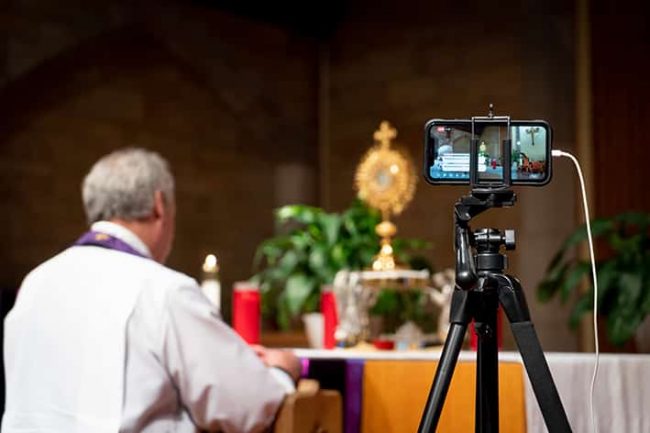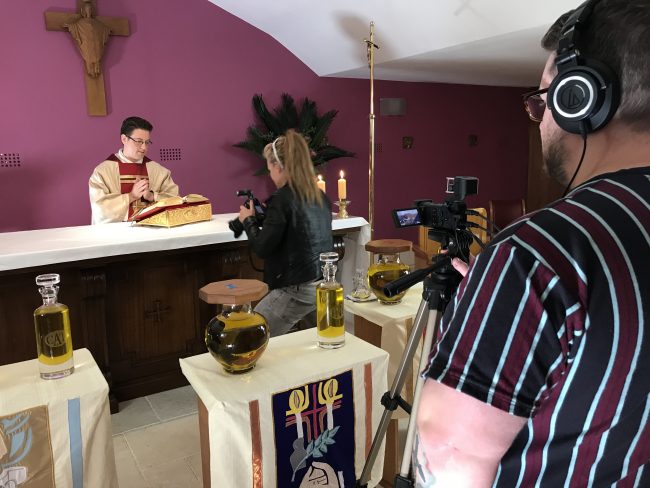What will the Catholic Church look like in 2021?

Adoration of the Blessed Sacrament is live-streamed on Facebook by Father Tom Kovatch at St. Charles Borromeo Catholic Church in Bloomington, Ind., March 24, 2020. Father Kovatch learned to livestream after all Catholic churches in the Archdiocese of Indianapolis were closed to stop the spread of the coronavirus. (CNS photo/Katie Rutter) See HOLY-WEEK-EASTER-LIVESTREAM March 30, 2020.
Prophecy is a risky business, but I’m happy to have a go at describing what the Church might look like in Australia after COVID-19.
For starters, I’m wondering if we’ll ever see holy water in stoups at the doors of our churches again – although I’ve been really impressed at the contactless holy water dispensers I’ve seen in some parishes.
And I am one of those germophobes who is really happy with the way we’ve swapped out the handshake Sign of Peace for a simple nod of the head or a smile and wave.
But the biggest difference you’ll probably notice is that there’s fewer of us at Mass on Sundays. I’ve just completed a national survey on the impact of COVID-19 on Catholic worship choices, and it’s been very interesting.
For some people, church closures have ended their relationship with the sacraments, which is really sad. Now that churches have re-opened, they’re simply not going to Mass anymore.
But for others, church closures were an opportunity to discover just how much they wanted to be with the living God in the Eucharist, and to be with other Catholics.
So they got creative – and I think this is something we’ll see more of in future, if we have to go through church closures again.
I watched with delight on Facebook and YouTube as priests all over the world set up drive-through confessions, walked or drove the Blessed Sacrament around towns, and went into hospitals in protective gear.
And people came. People came out on their front lawns or verandas and did Adoration in public. People met their priests at a safe distance in the parish church’s rose garden and went to Confession. People contacted priests and asked to receive Holy Communion safely outside of Mass.
Parish churches hosted toilet paper amnesties and organised food collections for people hit hard by the pandemic. Courageous priests made careful and well-sanitised home visits.

Fr Trenton van Reesch prepares to live-stream the Chrism Mass at St Christopher’s Crypt
And lay people welcomed them because this crisis has brought us closer together. Perhaps priests and people had been dangerously close to taking each other for granted before church closures came along.
You might notice that I’m focusing on real-life activities. That’s because the Catholic Church is a real-life church made of real-life people, who thrive when they do real-life worship.
We all tried the virtual worship thing, and it was okay for some of us. Livestreamed and televised Masses became a regular event in our homes. I kept meeting Catholics under 35 who were choosing to watch livestreamed Latin Masses as well.
Livestreaming has also been a great way for curious evangelical Christians to see firsthand exactly what we do in Mass and to realise that it’s not scary or secret. Some of them have become Catholics now, precisely because they love the other-worldly beauty of a Mass that’s really focused on worshipping God.
But virtual worship isn’t what gets people back into churches once they reopen. The thing that best predicts people coming back to Mass after COVID-19 is how often we were going to Mass in the first place.
The second-best predictor of coming back to Mass is how much real-life worship we engaged in while churches were closed, even if it was just praying in each other’s homes.
For most of us, what really got us through church lockdowns was real-life contact with priests and the sacraments and other Catholics.
I asked my participants what they’d like to see happen with real-life worship if churches have to close again. They overwhelmingly supported access to the sacraments with proper safeguards, so that everyone can stay healthy both physically and spiritually.
We know this is possible. It’s been done successfully in the United States, where there’s now a terrific set of guidelines for Catholics to use that meet World Health Organisation protocols for preventing the spread of infectious diseases.
So a future Church in Australia might be one where it’s possible for Catholics to receive the sacraments safely, even when our churches are closed and we can’t gather together.
My prediction for the future Church in Australia? A much smaller Church, and a younger Church, with more adult converts.
And it will be a real-life Church, not a virtual one – just like it’s always been.



Perhaps now is the time to talk about the bricks & mortar of the Church. With congregations shrinking due to both age & the Covid-19 who will pay for the upkeep of these buildings? This process will be a challenge in 2021 & will probably dominate many discussions in Catholic communities. With an increase in the loss of jobs & a continuous increase in homelessness, how will Catholics react. We need to remember the Words of Our Lord, when he said that when you showed compassion to the unfortunate in our communities you did it for me.
The misleading heading ‘What will the Catholic Church look like in 2021?’ is rescued by the first sentence, where it is clear only the Church in Australia is meant.
I am often struck by how many Catholics refer to ‘the Church’ meaning only the community in Australia.
For all that Cardinal Ratzinger said somewhere that ‘There is no right or left in the Church’, friends who would likely describe themselves as being on the Left, not uncommonly have little time for the faith of their Third World fellow Catholics and their relative lack of concern about ‘issues’ such as male clergy, church (non-)attendance, the consequential perceived need for liturgical, if not doctrinal, change, and the like.
Unless Australian Catholics seriously want to emulate Henry VIII Fid. Def., a broader, world perspective, and discussion, if not acceptance, of this perspective, could be a handy remedy. Instead of urging radical change to adapt to Australian perspectives which in several respects happen to no longer be Christian, this discussion might include analysis of why the Church in Australia seems likely to be smaller than a generation or two ago, while in many other countries this is not assumed to be the case.
I agree wholeheartedly, Luis; thankyou for sharing this perspective. The very word “Catholic” is often overlooked regarding discussions concerning the Catholic Church in Australia. Many Australian Catholics are ignorant of the meaning of the word “Catholic” and again are ignorant (sometimes wilfully so) that it is the Catholic Church IN Australia NOT the Catholic Church OF Australia. Again, thank you for bringing this issue to the very necessary forefront of our consciousness.
Luis,
While the Catholic Church is “Universal”, indeed the word means that, we are in practice separate Churches in Communion with Rome, where the Pope is also Bishop. Bishops and Arch Bishops have total responsibility for their Dioceses /Arch Dioceses. I am fortunate to have experience of both the ‘Western’ (Australian and English Catholic Churches), whilst also having an insight into the ‘other’ (Philippines Catholicity). The problem of priest shortage is not confined to the ‘western churches’, it is also an issue in the ‘other Churches’, particularly the Amazon Region for example. Whilst church attendances remain high in Africa, there has been a noticeable fall in South and Central America and the Philippines in recent decades.
The issues facing the Church in the west , for example the sexual scandals, are certainly not confined to that part of the world as we are beginning to find out. The questioning of Church authority is widespread throughout the Catholic world . Maybe improved education among the young in developing strongly Catholic countries is a reason for the ‘unrest’being observed there. Lastly Catholic teaching has evolved and is evolving as our understanding of Jesus’ message grows and matures. Doctrine has never been static in the Church.
I am very surprised at the comment about the US having “a terrific set of guidelines for Catholics to use that meet World Health Organisation protocols for preventing the spread of infectious diseases”.
Evidence shows clearly that Australia did extremely well with guidelines for public worship during the pandemic. I don’t think it’s wise to be holding up the US as an example with 3000 deaths there yesterday.